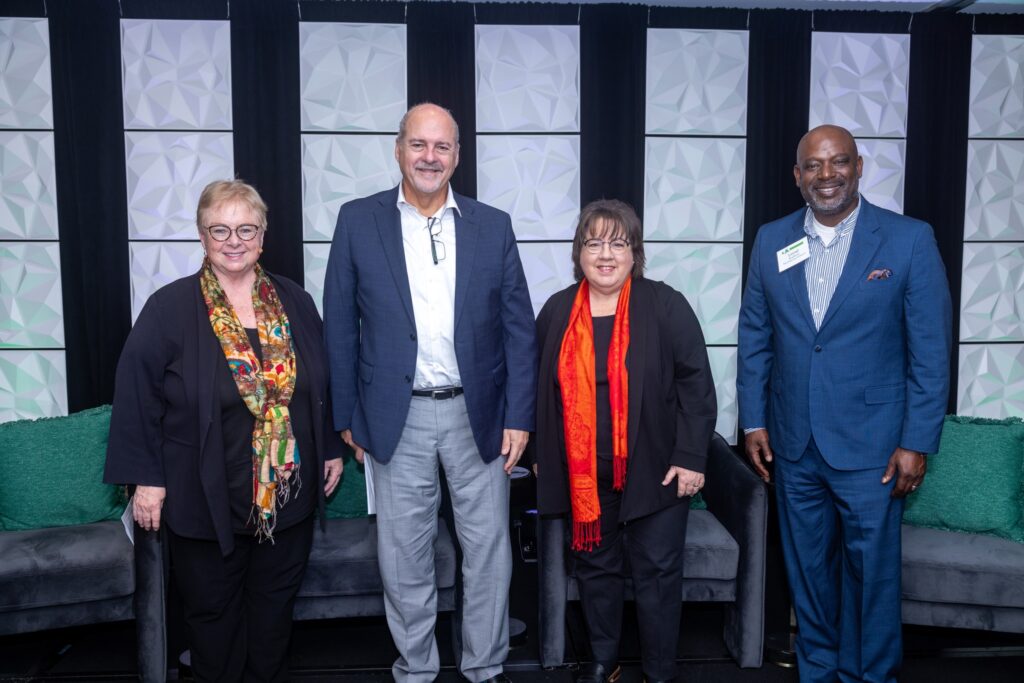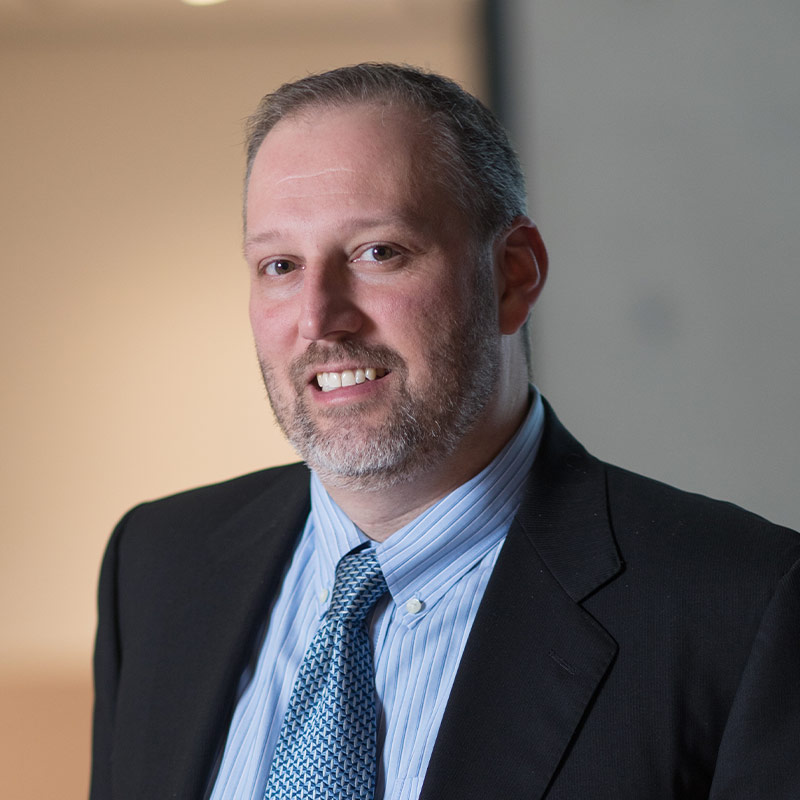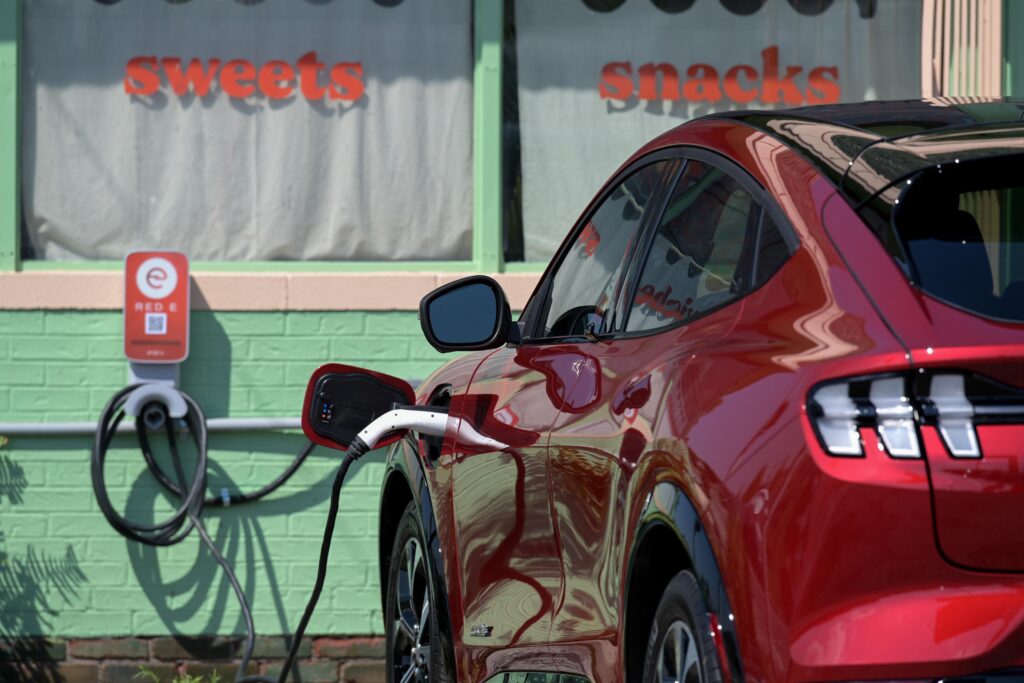Restoring Detroit’s Tree Canopy

Detroit was once known as the “city of trees,” but disease, invasive insects, and budget cuts over time have decimated our area’s distinctive tree canopy. But efforts are underway to replenish trees while also providing job training, green spaces, education, and community engagement. On Oct. 31, 2024, Sustainable Business Network Detroit hosted an informative discussion sponsored by the Fred and Barbara Erb Family Foundation regarding these efforts and how restoring tree canopy benefits individuals, neighborhoods, businesses, and the economy. The panelists were: Lionel Bradford, president and executive director, Greening of Detroit, a nonprofit focused on enhancing the quality of life for Detroiters by planting trees, providing job training, and involving youth in the education of the natural environment. It involves Detroiters in the process through community engagement, green spaces, education, and jobs. Maureen Donohue Krauss, president and CEO, Detroit Regional Partnership. DRP works to serve as a single point of contact for information, connection to services, incentives, and data for businesses who want to locate or expand in the 11-county Southeast Michigan Region. Robert Riney, president and CEO, Henry Ford Health, and leader of HFH’s $4 billion Destination: Grand initiative. The project includes a $2.2 billion expansion of HFH’s Detroit campus anchored by a new state-of-the-art hospital facility that will span 1.2 million square feet. It includes a 20-story patient tower, with three floors dedicated to providing intensive inpatient physical medicine and rehabilitation in partnership with the Shirley Ryan AbilityLab and its own Central Energy Hub, making it one of the largest fully electric-capable hospitals in the country. The event was moderated by Terry Barclay, president and CEO of Inforum, and chair of SBN Detroit. Some of the takeaways: The case for tree canopy Lionel: Growing up in Southeast Louisiana – which is very hot – you quickly learn the value of a tree. It’s also a sportsman’s paradise – We did a lot of hunting, fishing, and camping, and I developed a great appreciation for the environment and its value. I also love people. The work that we do is about people at the end of the day, so when we do this work it’s to build community and neighborhoods. We try our very best – changing landscapes and lives is our motto. When someone has been incarcerated for 20 years and needs a second chance, they can come through your program – the Detroit Conservation Corps – and they can be trained and support their families. You can train people to put trees in the ground and maintain them. Maureen: Part of my role is to inform people that economic development is more than just a new factory in your town, more than just a tax abatement. It’s creating an environment that both people and companies want to be in. Sixty percent of our projects are from international companies – when people come here for the first time, they have expectations of what a first-class city looks like… Think about Paris and its phenomenal tree canopies. People want that here. I did a little research before this event: Homes with trees sell two days faster and for 15% more than homes without. Tree value increases with age – the cost of trees has 100% payback. Three properly placed trees can reduce air conditioning by 56% and reduce home heating bills by 10% by serving as a windbreak. Bob: You may think what does a healthcare system have to do with tree canopies? HFH is absolutely committed to increasing the health of communities – the role that hospitals and doctors play is about 20%. We don’t underestimate the power of that 20%, but true health – meaning how long people will live and have a high-value life – is a partnership of healthcare, policy, and environmental factors – which are huge. You may have seen that the biggest determinant of your health is the ZIP Code that you live in. You need to have fabulous healthcare, access to it, economic security, environmental security, and food and nutrition security. At HFH we need to be a population health company – we pick and choose how we should make our mark and one of the things we believe in is the power of the tree. We have to walk the talk. The economic benefits of tree canopy Maureen: Our organization has three pillars: market, grow, and support. It’s so much better now. People are curious to hear about Detroit and see what’s happening. Talent is No. 1 – we have the second-highest amount of engineers in the country and have experienced manufacturing talent. As one of my teammates says, it’s workforce, weather, and water. When you talk about climate change, Michigan will be in the top five least affected. The right amount of tree canopy and how trees are sourced Lionel: American Forests did a study and determined that a city the size of Detroit should be at 40%. Right now we’re at 26%. We lose about 2,000 trees a year, so those have to be taken into account. We get most of our trees from New York and Indiana and, more recently, Wholesale Tree Inc. in Northern Michigan. More importantly, we’re growing our own trees now – running the Walter Meyers Nursery in Rouge Park, which is owned by the city. We’re very intentional about turning into a full-fledged operational business. Last year, we harvested our first set of trees. We have lost a lot of trees over time, and the reason we have lost a lot of those is because the city lacked the resources, and dead trees were not removed and were taken down by storms. This administration has done a great job by taking trees down when dead and dying. Working with DTE has been quite thrilling – they have given financial support to planting trees but also to making sure that the next generation of environmental stewards are trained by supporting our Green Corps summer programs and also the tree
Vehya – Working to Help Consumers and Businesses Electrify Faster

Detroit-based Vehya is a two-year-old marketplace, which offers services to businesses and individuals looking to adopt EV technology. SBN Detroit interviewed founder and CEO William McCoy to find out more. Q: What can you tell us about Vehya? A: Vehya (pronounced and meaning “via”) is a marketplace for electrification. With everyone moving (or trying to move to) electrification quickly for a sustainable future, we know the project management – research, execution, installation, maintenance – portion can be challenging. So, we created a platform that makes that process easy. Before, if a consumer or office wanted to get an easy charger, they would have to find an electrician, vet them, research products to find the best solution, schedule installation, etc. Vehya turns those steps into a turnkey process. We sell electric vehicle chargers, solar, battery storage, and other resiliency products and have a network of certified service providers to install and service them. Q: Are the end users consumers or businesses? A: Both. In the beginning, we focused more on the commercial and quickly realized there was just as much of a need on the consumer side. The people we were working with on commercial projects were asking if we could do this for them at their homes, or for their clients so we created a consumer-facing platform as well. Q: What needs do you believe Vehya solves? A: People and businesses that are looking to transition to electric often do not have the time or resources for the research and logistics involved. So, we fill that gap. Early adopters will jump in and figure it out, but for others – for the mainstream – they need help. We streamline the process to help both consumers and businesses electrify faster. Q: Tell me about your new partnership with DTE. A: DTE was looking to help their customers streamline the process of obtaining electric vehicle chargers both from a financial and logistical standpoint. They launched an RFP and ultimately chose Vehya for this partnership, which we are so happy to participate in. It’s a fantastic program because it opens the door for many more people to make the transition to EV who couldn’t without the financing DTE’s program offers. Further, many homes need service panel upgrades to support EV charging and that is an additional cost, so the financing becomes even more important. Customers can now come onto the platform, buy a charger and have it shipped to their home, identify an electrician to install it, and sign up for financing all in one place. Through this program, we’ve had about 2,500 enter the platform chargers and have facilitated close to 400 installs in the three months since it launched. Q: Tell me about the partnership with Stellantis A: In March, we became a preferred partner for EV charger sales, installation, and maintenance for Stellantis’ U.S. auto dealers. Our program includes Vehya-certified electricians, detailed site surveys, comprehensive estimates, and a dedicated account manager that handles all administrative and project management duties. Q: How is the Vehya marketplace different than other platforms? A: The fact that we offer products, service providers, and project management is different than other platforms. You can buy a charger on a marketplace like Amazon but then you have to figure out the installation. We vet and certify our service providers as well. Q: Tell me about that vetting and certification process. A: Most of our electricians are certified by the Electric Vehicle Infrastructure Training Program (EVITP). We then certify them regarding experience and licensing. They must have the highest levels of insurance. And we do a background check. Q: How do you think the work you do impacts Southeast Michigan businesses? A: A lot of businesses want to electrify their fleets and company cars but don’t know where to start and don’t have the resources to do the research. Workforce development and job creation are also important pieces to us. Vehya is the marketplace that connects consumers and businesses with highly qualified service providers. It connects these service providers to people raising their hands for help in turn creating and bolstering careers. Q: What does the future look like for the company? A: We are working to make our online processes even quicker and to scale our offering. We are also working with underserviced communities to take advantage of EV transition opportunities as well. Financing is key. An average install in the Detroit area is $2,300, because as I had mentioned, a service panel upgrade is typically needed. We are working with banks now to put together consumer packaging to spur adoption and make it easier for more people. Equity and inclusion have to be considered – we need everyone to be a part of this. Be sure to subscribe to our newsletter for regular updates on sustainable business practices in and around Detroit.
Improved Green Loan Access for Detroit Small Businesses, Nonprofits, and Residents

In 2009, the State of Michigan created the nation’s first nonprofit “green bank” called Michigan Saves. The organization provides credit enhancements for credit unions and other lenders that reduce their loan default risk. In exchange, the lenders lower interest rates to help homeowners to pay for home improvements that reduce fossil fuel use, such as high-efficiency appliances like furnaces, central air, and water heaters. That means lower greenhouse gas emissions. Fast forward to 2022 at which time Michigan Saves secured a $2.5 million loan from the Kresge Foundation and developed the Detroit Loan Fund, fundamentally changing the loan process to approve more loans for residents, and now nonprofits and small businesses in Detroit. The fund eliminates credit scores as loan criteria, focusing instead on the borrower’s ability to make loan payments. In nine months, Michigan Saves through the fund has reached a $1 million milestone in loans. SBN Detroit talked to Todd Parker, vice president for Michigan Saves, about how the fund benefits residents, nonprofits, small businesses, the economy, and the environment. Q: How does this help nonprofits and small businesses in Detroit qualify for loans? A: Yes, especially in today’s financial environment with rising interest rates because the program provides 7% fixed-interest-rate loans and, therefore, financial certainty. The Detroit Loan Fund provides funding to Detroit nonprofits, community organizations, and small businesses for solar photovoltaic, battery storage, or electrification projects. The loans provide direct financial benefits in the form of utility savings and have longer terms than most commercial loans – seven to ten years. Customers may also be eligible for federal tax credits, which further improves the business case for the loan. In all, the loan provides great terms and affordable funding for those who have not been able to receive it before. Q: Is this model of lending unusual? A: Yes. Regarding the residential component, we are focusing on the ability of the loan recipient to pay, and not simply their credit score. Very few, if any lenders do this. Commercial lending is more competitive. A 7% loan in this environment that does not rely on credit criteria is innovative. We tried to develop these programs to fill a market niche and do something other lenders are not. Q: What was the path to creating these loans? A: These loans were developed because we analyzed the loan application denial rate and saw that Detroit homeowners are denied twice as much as others in Wayne County. This systemic inequity has been baked into the credit process for years. We knew something had to be done. Detroit has been underserved for years and a loan product like this opens many doors for the betterment of the city. The concept could work statewide as well. Q: Is the intention to go statewide with these loans? A: If funding comes through yes, we’d like to expand statewide. Rolling it out in Detroit allowed us to test it, and it’s been very successful. Q: From the residential perspective, how does assisting those who have been denied previously in getting loans for energy efficiency programs help the overall communities? A: The program is designed to target customers who have the highest energy burden. Those who are paying the most for energy relative to their income. Old homes lack insulation and lack quality windows and high-efficiency heating and air. The loans allow people to reduce their utility bills but also improve the health and safety and comfort of their homes. Providing comfort and savings is our goal. Q: It also helps the environment, yes? A: Yes. It certainly helps reduce greenhouse emissions and the carbon footprint. On the commercial side, the nonprofit and small business program targets solar PV (photovoltaic) systems, which allows them to generate energy and put it back on the grid as well as get bill credits, so there are environmental and financial benefits there as well. Q: What are the criteria for accessing these loans? A: The criteria are simple. Small businesses or nonprofits simply need to demonstrate they can pay by showing cash flow. We are less focused on traditional underwriting criteria. And more focused on a holistic view to make sure they have the means to repay. Q: What else do we need to know? A: The loan programs are contractor driven, meaning they are promoted through our network of authorized contractors. Also, we get referrals from utilities like DTE, community action agencies, or other community groups. Ultimately the nonprofit or business will then enter into a direct relationship with the lender. Q: How does the lending process with businesses impact nonprofits? A: These types of measures are being heavily incentivized through the Inflation Reduction Act. It’s an exciting component for nonprofits, who don’t have to pay taxes and therefore cannot take advantage of tax credits. The IRA legislation changed the game by saying nonprofits are eligible for direct pay equivalent of a tax credit when they invest in solar PV or battery storage systems. This changes the financial picture and opportunities dramatically and provides a direct financial incentive for nonprofits. Q: How do you see it impacting the future of Detroit and the economy? A: Our funding will be exhausted this summer. If we get additional funding to continue the program, we will be able to help significantly more homeowners. Currently, we are already approaching 250 projects. On the commercial side, once the federal government releases guidance and more funding, we expect nonprofits and businesses to package this funding with federal grants and tax credits to make the projects more financially attractive. The loans also help customers deploy energy-saving steps, and therefore save on utility bills while potentially generating revenue from tax credits. These savings free them up to apply that money elsewhere and put them in a better financial position. This goes for both residents and businesses. Also, we are working with Detroit-based contractors on installing these solar and energy improvements, so the money stays local. Be sure to subscribe to our newsletter for regular updates on sustainable
DTE Talks About the Challenges and Opportunities in Building and Adopting EV Infrastructure

Widespread electric vehicle (EV) adoption is crucial for achieving climate goals. However, the pace of EV adoption varies significantly across different income sectors, markets, and geographies. There are significant barriers to EV entry that are hindering the overall pace of electrification including lack of charging infrastructure (range anxiety), charger access disparities, and affordability. Addressing these challenges is critical. SBND talked with Tony Tomczak, vice president of electric sales marketing for DTE Energy, about the company’s initiatives and partnerships designed to build infrastructure and capacity. Q: Is growth in EVs outpacing charging stations? How is DTE is working to address this? A: Yes, at the current rate of adoption, EVs are outpacing EV chargers. From January 2020 to October 2022, public EV chargers in Michigan increased from 1,070 to 2,300 and EVs increased from 21,500 to about 44,500. We recognize that access to EV chargers across the state can be a barrier for many when deciding to go electric. We offer businesses thousands in rebates to incentivize them to install EV chargers at their business, including retail, workplaces, multiunit dwellings, and schools. In the Q4 2022 report that we filed with the MPSC, we shared that we have approved 2,300 residential Level 2 EV chargers, 1,130 Level 2 rebates, and 120 CFC rebates. You can learn more about our business rebate program here. Q: A significant barrier to entry in EV ownership is range anxiety. What are the goals to convert drivers to EVs and the infrastructure in place to support them? A: The current charging infrastructure is not enough. While the biggest barrier to EV ownership is still the upfront vehicle and charger cost, range anxiety is also a barrier many of our customers face. The State of Michigan has an aspiration to deploy enough charging infrastructure to support two million EVs on the road by 2030. While we’re still a long way from that volume of EVs, in the meantime DTE is facilitating charging deployment through our EV programming and other partnerships to leverage available funding. Q: Michigan will receive a $110 million grant from the National Electric Vehicle Infrastructure (NEVI) Formula Program, as part of the Federal Infrastructure Law. There is a plan in place to install four 150 kilowatt – or greater – vehicle chargers spaced no more than 50 miles apart along each of the state’s designated Alternative Fuel Corridors, which include all seven of the state’s major highways that will serve as the backbone of Michigan’s vehicle charging network. These include I-96, I-75, I-696, I-275, I-69, I-196 and I-94. What is DTE’s involvement with this? The plan, and timing, is this enough? A: The plan is to closely collaborate with the Michigan Department of Environment Great Lakes, and Energy (EGLE) to review and identify ideal sites that are eligible for NEVI funds and which can be layered with our EV programming incentives and rebates. Ideal sites are defined as well-lit areas that are publicly accessible 24/7, and usable by people with disabilities. Preference will be given to sites that have amenities for the EV drivers (e.g., food, bathroom, seating indoors) within 0.25 miles of walking distance on pedestrian-friendly routes and are within two miles of driving distance of an interstate, U.S., or state highway. We will be participating with the state’s committee to review and vote for NEVI projects. The EGLE request for proposal (RFP) solicitation to organizations that are interested in receiving NEVI funding is scheduled to go out this winter, and the committee will come together sometime in Q2. NEVI projects will begin to be awarded later this year. Additionally, since DTE’s Charging Forward rebated make-ready model leverages other funding by design, we will continue to collaborate with EGLE’s Charge Up Michigan team. Since launch, we have approved 48 Charging Forward sites which will also receive a combined $1.3 million in funding from the Volkswagen (VW) settlement funds that EGLE is managing. There is another potential ~$5 million in funding currently going through the Charge Up Michigan evaluation process, and DTE will continue to work closely with state agencies as the process for NEVI funding distribution becomes clearer. Q: According to the Michigan Future Mobility Plan, the state will install 100,000 vehicle chargers to support 2 million electric vehicles by the year 2030. To meet the goal over 12,000 vehicle chargers would need to be installed per year. Is this possible? What is DTE’s involvement? A: Similar to our involvement with the EGLE program, DTE partners with the Michigan Future Mobility Plan by facilitating charging deployment through our EV programming and leveraging their partnership for additional available funding. To date, we have installed over 780 public chargers within the communities in our service territory and will continue to do so with the continued EV programming rebates and incentives. Q: Michigan is quickly becoming a center of U.S. battery manufacturing. What are the job implications of this? A: We are excited that many electric vehicle automakers and suppliers, including battery manufacturers, are continuing to call Michigan home. One of the many benefits of driving electric vehicles is knowing that the fuel is made in Michigan, by Michiganders, which stimulates our local and state economies. The significant amount of charging infrastructure required is creating jobs for local installers and maintenance providers. The DOE has the JOBS EVSE tool which allows users to estimate the economic impact of EVs, including charging infrastructure, job creation, and local spending. Q: What can you tell us about your partnership with Volta Charging which received a Michigan Mobility Funding Platform grant and other programs we haven’t talked about so far? A: Our portfolio of EV programming is designed to reduce the barriers to EVs for our customers. Our partnership with Volta was just one example of bringing our goals to fruition and enabling equitable access to EVs by deploying chargers in lower-income or rural communities that have not seen as much investment to date. Volta chargers are unique since they also act as a platform for education with their


